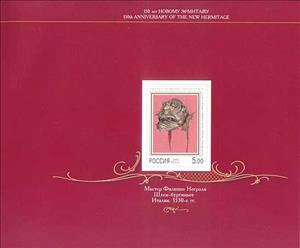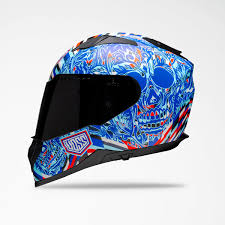Booklet Pane: Master Filippo Negroli, Burguignot Helmet (1530's) (Russia 2002)
Master Filippo Negroli, Burguignot Helmet (1530's) (Russia 2002)
15 February (Russia ) within release 150th Anniversary of New Hermitage Museum, St. Petersburg goes into circulation Booklet Pane Master Filippo Negroli, Burguignot Helmet (1530's) face value 5 Russian ruble
| Booklet Pane Master Filippo Negroli, Burguignot Helmet (1530's) in catalogues | |
|---|---|
| Michel: | Mi: RU HB18 |
Booklet Pane is horizontal format.
Text in Russian and English.Also in the issue 150th Anniversary of New Hermitage Museum, St. Petersburg:
- Booklet Pane - 150th Anniversary of New Hermitage Museum, St. Petersburg face value 15;
- Booklet Pane - Courtesan, Hendrik Goltzius (1606) face value 2.50;
- Booklet Pane - Ecco Homo, Peter Paul Rubens (c.1612) face value 2.50;
- Booklet Pane - Gonzaga Cameo (Aleksandriya, 3rd cent. BC) face value 5;
- Booklet Pane - Master Filippo Negroli, Burguignot Helmet (1530's) face value 5;
Booklet Pane Master Filippo Negroli, Burguignot Helmet (1530's) it reflects the thematic directions:
An anniversary is the date on which an event took place or an institution was founded in a previous year, and may also refer to the commemoration or celebration of that event. For example, the first event is the initial occurrence or, if planned, the inaugural of the event. One year later would be the first anniversary of that event. The word was first used for Catholic feasts to commemorate saints. Most countries celebrate national anniversaries, typically called national days. These could be the date of independence of the nation or the adoption of a new constitution or form of government. The important dates in a sitting monarch's reign may also be commemorated, an event often referred to as a "Jubilee".
A helmet is a form of protective gear worn to protect the head. More specifically, a helmet complements the skull in protecting the human brain. Ceremonial or symbolic helmets (e.g., a policeman's helmet in the United Kingdom) without protective function are sometimes worn. Soldiers wear combat helmets, often made from Kevlar or other lightweight synthetic fibers.
A museum (/mjuːˈziːəm/ mew-ZEE-əm) is an institution dedicated to displaying and/or preserving culturally or scientifically significant objects. Many museums have exhibitions of these objects on public display, and some have private collections that are used by researchers and specialists. Compared to a library, a museum hosts a much wider range of objects and usually focus around a specific theme such as the arts, science, natural history, local history, and other topics. Public museums that host exhibitions and interactive demonstrations are often considered to be tourist attractions, and many museums attract large numbers of visitors from outside their host country, with the most visited museums in the world regularly attracting millions of visitors annually.



